
| Random files - Stkp's Gallery |
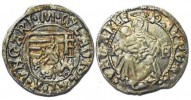
Huszár 807, Pohl 242-2, Unger 641b, Réthy II 272B, Kaplan Subtype AHungary. Wladislaus II (Ulászló II in Hun.) (1490-1516). AR denar, .49 g, 15 mm.
Obv: M ⢠WLADISLAI â¢R ⢠VNGARI â¢, Four-part shield with Hungarian arms (Ãrpádian stripes, patriarchal cross, Dalmatian leopard heads, Bohemian lion), Polish eagle with outstretched wings in center.
Rev: PATRONA ⢠â ⢠VNGARIE, Crowned Madonna with infant Jesus to her right, KâH (privy mark) in fields.
The type was struck 1498-1503 (per Unger) or 1500-1502, except for one rare mint mark that was struck ca. 1505 (per Pohl). This privy mark was struck in Kremnitz (formerly Körmöcbánya, Hungary, now Kremnica, Slovakia) by Hans Thurzó (per Pohl).
Huszar/Pohl rarity rating 3. Subtype A is the form of the emission, in which the bottom of the Madonnaâs robe has a single distinctive fold in its center (depicted in Huszár and Pohl, but not described in Huszár, the text of which is erroneous in its description of the Madonna on this emission). Subtype A is rare with this privy mark.
aUnc with bronze patina.Stkp
|
|

Elymais. Arsacid dynasty. Orodes III (2nd century A.D.)van't Haaff 16.2.1-2A; De Morgan 25-26; BMC plate XXXIX, 17-20, page 257 46-47; Sear GICV 5893-5894 (Orodes I); Alram --
AE drachm, 3.64 g., 13.61 mm. max., 0°
Obv: Bust facing left, wearing tiara with anchor and dotted rim, diadem band below tiara, ribbon falling behind bust from dot; to right pellet within crescent above anchor with one crossbar at top; pellet border.
Rev: Bust of Belos, left, with bead necklace and earings; cornucopia behind; pellet border.Stkp
|
|

Japan. Tokugawa Shogunate. Shin-Kanei Tsuho (new Kanei Tsuho). Fukyu-te: Jumantsubo-senHartill 4.126-6a var. esp. 4.126a; Jones (2007) 218 var; KM C 1.1 var; Zeno # 252017
1 mon (cast copper alloy), cast 1726-1732 (Kyoho 11-17), Jumantsubo, Fukagawa-Edo (Musashi Province); 2.58 g., 24.10 mm. max.
Seven mints cast coins in Fukyu-te (Fukyu script, or âin the manner of Fukyuâ), which are named after a Nagasaki merchant who studied the series. The distinguishing characteristics are a prominent protruding çª tsume/claw at the bottom left of the è² kai component of 寶 ho, and a closed ã ma/head on é tsu. The head of the æ°¸ ei is also drooping. On the Zeno website, the coins in the series are orgamized as âThe five mints of Kanei Tsuho with the character EI inclined to the left,â although in many cases this inclination does not appear to be present.
Hartill lists just two varieties of Fukyu-te from the Junantsubo mint, and Jones lists one. Hartill notes that specialist works list many varieties of Fukyu-te (without reference to the number specifically from this mint). The paper, Guide for Identification of Cash Coin Kanei Tsuho with the Character EI Inclined to the Left, identifies three varieties. Hartill notes that the varieties of Fukyu-te are difficult to tell apart. This is an understatement. The coins cast by the different mints can often be distinguished principally by size and weight, with those cast at Jumantsubo having a diameter of about 24.0 mm. and a weight of about 2.8 g. On almost all those cast at Jumantsubo, the legs of 寶 ho are lower than the central hole.
This variety is called å°ç®å¯¶ Shomokuho (roughly small me component on ho), in which the legs of å¯ kan are high (é«å¯ Kokan), the æ°¸ ei is centered (éæ°¸ Taiei) with a distinct hook of the right arm; the ç® me component of 寶 ho is small and the feet of ho are even with the central hole.
Hartill rarity VCStkp
|
|

Carian Islands, RhodesSear 5074 var., SNG Copenhagen 750-751 & 858-9, SNG Helsinki 384-392 var., SNG Keckman 384-421, SNG von Aulock 2796-2797 var., BMC Caria pg. 238-239, 74ff var., Laffaille 503 var.
AE 10, circa 350-300 B.C.
Obv: Diademed head of Rhodos right, hair rolled.
Rev: P-O in lower field, rose with bud to the right, H to the left.
In 408 B.C., the cities on the island of Rhodes united to form one territory and built the city of Rhodes, as their new capital on the northern end of the island. The Peloponnesian War had so weakened the entire Greek culture that it lay open to invasion. In 357 B.C., the island was conquered by the king Mausolus of Caria, then it fell to the Persians in 340 B.C., and in 332 B.C. became part of the empire of Alexander the Great. Following the death of Alexander, his generals vied for control of his empire. Rhodes formed strong commercial and cultural ties with the Ptolemies of Egypt, and together formed the Rhodo-Egyptian alliance that controlled trade throughout the Aegean in the 3rd century B.C. The city developed into a maritime, commercial and cultural center, and its coins circulated nearly everywhere in the Mediterranean. In 305 B.C, Antigonus directed his son, Demetrius, to besiege Rhodes in an attempt to break its alliance with Egypt. Demetrius created huge siege engines, but despite this engagement, in 304 B.C., he relented and signed a peace agreement, leaving behind a huge store of military equipment. The Rhodians sold the equipment and used the money to erect a statue of their sun god, Helios, which became known as the Colossus of Rhodes.
In Greek mythology, Rhodos was the goddess of the island of Rhodes and wife of Helios. She was the daughter of Aphrodite and Poseidon.Stkp
|
|

RIC VII Siscia 222Rome mint, third officina, struck under Constantine I, 330-333 A.D.
AE3/4, 2.37 g., 18.73 mm., 0°
Obv: VRBS ROMA, helmeted plumed bust of Roma left, wearing imperial cloak.
Rev: She-wolf standing left, suckling the twins (Romulus and Remus), two stars above, ÃâSIS in exergue.
RIC rarity C3Stkp
|
|

Elymais. Arsacid dynasty. Prince A (late 2nd to early 3rd centuries A.D.)van't Haaff 19.1 var.; de Morgan 58-59; BMC plate XLII, 13-18, page 286, 18; Sear GICV 5918-5919; Alram --
Elymais. Arsacid dynasty. Prince A (late 2nd to early 3rd centuries A.D.)
AE drachm, 1.54 g., 11.01 mm. max., 0°
Obv: Bust facing left, wearing diadem of two bands, row of dots above, side whiskers as double row of dots, hair tuft at back of head; to left anchor with at least one crossbar; pellet border.
Rev: Artemis standing right, holding bow in one hand, plucking arrow from her quiver with the other hand; pellet border.
According to van't Haaf, the varieties with a hair tuft are "always" accompanied by a dot or star in crescent above and an anchor to the right, although these symbols are often struck off the flan. This is an unrecorded variety in which the anchor is to the left.Stkp
|
|
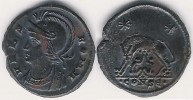
Urbs Roma ConstantinopleRIC VII Constantinople 85
Constantinople mint, fifth officina, struck under Constantine I, 333-335 A.D.
AE3, 19 mm.
Obv: VRBS ROMA, helmeted (plumed) bust or Roma left, wearing imperial cloak
Rev: She-wolf standing left (circle of pellets [?] and tuft [?] on shoulder), suckling the twins (Romulus and Remus), two stars above, â¢CONSE⢠in exergue.
RIC rarity r3
Stkp
|
|
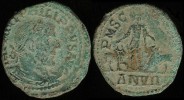
Viminacium (Moesia Superior). Philip I, the Arab (244-249 A.D.) (Marcus Julius Philippus) Pick 103, Martin 2.14.1 & 2.14.4, Jekov 30, Boric-Brescovic 716-826, Moushmov 36.
AE Sestertius, 27-29 mm, die alignment 180°
Dated Year 7 (246-247 A.D.)
Obv: IMP M IVL PHILIPPVS AVG, laureate, draped, cuirassed bust seen from behind.
Rev: P M S Câ[OL VIM], AN VII in exergue, Moesia standing, between a bull and a lion.Stkp
|
|
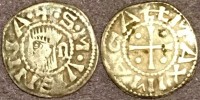
France (Feudal): Vienne, Archbishopric, 11th and 12th CenturiesRoberts 5045, Poey d'Avant 4828 Plate CVI/17, Boudeau 1046.
Billon denier, Vienne mint, ca. 1200-1250: .82 g. 17.35 mm. max., 270
Obv.: + S ⢠M ⢠VIENNA ⢠(= Saint Maurice of Vienne), bearded head of St. Maurice left.
Rev.: MAXIMA GALL (= Greater Gaul), cross with pellets.
Vienne was the first bishopric of Gaul, occupied by the legendary St. Crescens. The bishops became archbishops around 450 A.D. Its archbishops and those of Lyon disputed the title of "Primate of All the Gauls" based on the dates of founding of the cities compared to the dates of founding of the bishoprics.Stkp
|
|
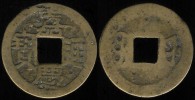
Schjöth 1500, Hartill (QC) 9.16 Type 1 & (CCC) 22.502, KM 464Jiaqing (1796-1820)
1 cash (cast brass), 1796 â 1800 [?], Fujian Province (in Fuzhou), 21 mm.
Obv: Jiaqing tongbao.
Rev: Boo fu.
Type 1 is comprised of coins with a six and a large ji in jia. They are of good size and workmanship. This is a smaller local variation.
Hartill rarity 10 (QC) & 15 (CCC)Stkp
|
|
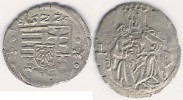
Huszár 846, Pohl 258-2, Unger 675e, Réthy II 308A, dated 1522 Hungary. Louis II (Lajos II in Hun.) (1516-1526). AR denar, 16 mm.
Obv: 1522, with rosettes on either side of date, above four-part shield with Hungarian arms (Ãrpádian stripes, patriarchal cross, Dalmatian leopard heads, Bohemian lion), Polish eagle in escutcheon, rosette between two pellets on sides of shield.
Rev: Crowned Madonna with infant Jesus to her right, LâK (privy mark) in fields.
The type was struck 1521-1525 (per Huszár & Unger) or 1521-1526 (per Pohl). This privy mark was struck in Kremnitz (formerly Körmöcbánya, Hungary, now Kremnica, Slovakia) (per Pohl).
This type was an inflationary currency that was referred to by contemporaries as âmoneta nova.â On average, 400 denars, each weighing 0.49 g., were struck form Ofner mark of silver with a fineness of 0,250 (per Huszár). They were officially valued at ½ a denar, but the public did not accept them at this overvalued rate (per Huszár & Pohl).
Huszár/Pohl rarity rating 4.
Stkp
|
|
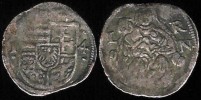
Huszár 853, Pohl 258-33, Unger 677b, Réthy II 313, dated 1524 Hungary. Louis II (Lajos II in Hun.) (1516-1526). AR denar, .53 g, 14.50 mm. max., 180°
Obv: Four-part shield with Hungarian arms (Ãrpádian stripes, patriarchal cross, Dalmatian leopard heads, Bohemian lion), Polish eagle in escutcheon, 1 with pellets above and below to left, [⢠52] ⢠above, and 4 with pellets above and below to right.
Rev: Crowned Madonna with infant Jesus to her right, LâR/N (privy mark) in fields.
The type was struck 1524-1525 (per Huszár & Unger). Pohl classifies this type as a mintmark variety of Huszár 846, Unger 675, Réthy II 308A. That type was an inflationary currency that was referred to by contemporaries as âmoneta nova.â On average, 400 denars, each weighing 0.49 g., were struck from an Ofner mark of silver with a fineness of 0,250 (per Huszár). They were officially valued at ½ a denar, but the public did not accept them at this overvalued rate (per Huszár & Pohl). This privy mark was struck in Nagybánya (now Baia Mare, Romania) (per Pohl).
Huszár rarity rating 6. Stkp
|
|

Elymais. Arsacid dynasty. Prince B (3rd century A.D.)van't Haaff 20.1.1-1A; de Morgan 60; BMC plate XLII, 19-20, page 287, 4-6; Sear GICV 5920; Alram --
AE drachm, 3.01 g., 15.05 mm. max., 90°
Obv: Bust facing left, wearing diadem of two bands, hair tuft on top of head tied with ribbons, its ends flowing behind, another hair tuft at back of head; to right, pellet-in-crescent above anchor; pellet border.
Rev: Athena standing right, holding spear in right hand, and shield in left; pellet border.
According to van't Haaff, the pellet-in-crescent and anchor are often off the flan, as in this coin.Stkp
|
|

Huszár 546, Pohl 88-1, Unger 437a, Réthy II 88, Frynas H.25.43Lajos/Louis I (1342-1382)
AR obulus, .30 g., 12.57 mm. max., 90°
Obv: mVnETA LODOVICI, Patriarchal cross.
Rev: + DEI GRACIA R VGARIE (with the ARs in ligature), shield with coat of arms (Ãrpadian stripes and Angevin fleur de lis).
The type was struck in 1372 per Pohl and Gyöngyössy, in 1371 per Huszár, in 1371-1372 per Unger and ca. 1371 per Frynas.
Huszár/Pohl rarity 5, Unger value 25, Frynas rarity N. The obverse of this coin is unusual in that (a) there are no pellets at the ends of the cross arms; and (b) the obverse legend starts with mVn rather than mOn. Coin No. 730 in Gyöngyössy (which bears a lily mint mark) also bears these features. The reverse legend is variable. This coin comports with the reverse legend in Unger.Stkp
|
|

Macedonian Kingdom. Philip III Arrhidaios (323-317 B.C.)Sear 6781 var.; Price 2064.
AE half unit, 4.25 g., 16.77 min. max., 270°
Struck by Asander/Asandros in the name of Alexander III, the Great, circa 323-319 B.C., at the Miletus mint [?] (per Price) or the Kaunos mint (based on find spots, per Ashton).
Obv.: Macedonian shield with Gorgoneion on central boss.
Rev.: Crested Macedonian helmet, flanked above by B--A (=ÎÎΣÎÎÎâ¦Î£ ÎÎÎÎÎÎâΡÎÎ¥), double-axe to lower left and K to lower right.Stkp
|
|

Jewish Home for Aged (Portland, Maine)AE token, 35 mm, undated.
Obv: JEWISH HOME FOR THE AGED, and ⢠PORTLAND - MAINE â¢, within border around rim, 25¢ to left and right of building in center, SOUVENIR below building.
Rev: KEEP ME and GOOD LUCK within border in upper and lower rim, âתש×××× × / ×צת ××§× × ××â [Do not cast us off in our old age. (Psalm 71:9)] and DO NOT CAST US / OFF AT OUR OLD AGE, in center, between profiles of elderly man and woman facing left and right, respectively.
Ref: Randolph, Marc A. âJewish Homes for the Aged Tokens,â The Shekel, XXXVI No. 3 (May-June 2003) 14-19, Figure 1.
Note: Founded in 1929 and based on North Street, where it remained until 1965. It continues to exist as the Cedars Nursing Care Center.Stkp
|
|

Schjöth 1495, Hartill (QC) 25.45 Type 1, KM 453.1Jiaqing (1796-1820)
1 cash (cast brass), 1797 â 1818 [?], Yunnan Province (YÃ
«n mint name), Yunnan-fu mint, 25 mm.
Obv: Jiaqing tongbao.
Rev: Boo yÃ
«n.
Type 1 is comprised of coins with a six stroke bei and a closed head tong, per the Board of Revenue reform type (cf. Schjöth 1489, Hartill (QC) 5.140 Type A1, KM 440.1)
Hartill rarity 10Stkp
|
|
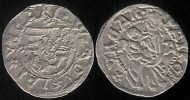
Huszár 807, Pohl 242-3, Unger 641c, Réthy II 272B, Kaplan Subtype CHungary. Wladislaus II (Ulászló II in Hun.) (1490-1516). AR denar, 15-15.5 mm.
Obv: * WLADISLAI * VNGARI â¢, Four-part shield with Hungarian arms (Ãrpádian stripes, patriarchal cross, Dalmatian leopard heads, Bohemian lion), Polish eagle with outstretched wings in center, rosettes above and to sides of shield.
Rev: PATRON * R VNGAR â¢, Crowned Madonna with infant Jesus to her right, n-A (privy mark) in fields.
The type was struck 1498-1503 (per Unger) or 1500-1502, except for this privy (per Pohl). This privy mark was struck in Nagybánya (now Baia Mare, Romania) in 1505 Ambrosius Literatus, kammergraf (per Pohl).
Huszar/Pohl rarity rating 3. This is a rare privy mark. According to Huszár and Pohl, there are one to three stars on the coins bearing this mark, on the obverse above and to the sides of the shield. The style of the Madonnaâs robe and crown do not fit within Kaplan Subtypes A and B, and are assigned to a catch-all Subtype C.Stkp
|
|

Anonymous 12th Century Class I. Huszár 100; Toth-Kiss 18.12.1.3 sigla h1.3/96; Unger 52 var. (wedges); Réthy I 88 var. (wedges); Frynas H.11.10; Lengyel 11/15B; Adamovszky A106cAnonymous 12th Century Class I; attributed to Béla II (1131-1141) by Lengyel and tentatively attributed to him by Unger, Frynas and Adamovszky , but this attribution is not accepted by Huszár, Toth-Kiss and Gyöngyössy.
AR denar (average: .38 g., 12.0-13.0 mm.), .45 g., 12.95 mm. max.
Obv: Pellets within crescents within arms of central cross.
Rev: Wedges instead of an inscription, cross.
Struck in Esztergom.
Huszár rarity 6, Toth-Kiss rarity 25, Unger rarity 10, Frynas rarity C.Stkp
|
|
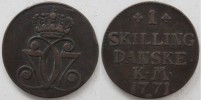
Denmark. Christian VII (1766-1808) Copenhagen Type 8C, reverse/obverse die combination C854/CO824Copenhagen Type 8C, reverse/obverse die combination C854/CO824 (uncommon = 20-50 coins); Hede 37, Schou 9-21, Sieg 2, Pedersen __, KM 616.1
1 Skilling, copper (11.693 g.). Copenhagen mint; immobilized date 1771 but Type 8 coins were minted between September/October 1783 and July 1785, with a hiatus for around nine months starting in late 1784. Dies made at the Copenhagen mint by Johan Ephraim Bauert, possibly assisted by his son, Georg Valentin Bauert, although Georg was only officially apprenticed at the Mint in May 1784.
11.58 g., 30.03 mm. max., 0°
Obv.: Crowned double C7 monogram.
Rev.: 1 flanked by rosettes / SKILLING / DANSKE / K ⢠M ⢠/ 1771 ⢠/ rosette, in six lines.
Of the 54,757,104 1771-dated 1 skilling coins minted over a period of 16 years (1771-1786), an estimated 30,000 to 50,000 exist. There are 984 known die combinations. They were minted at three mints. Copenhagen Type 8 comprises 7.6% of the total.
Attribution assistance courtesy of Eivind Lotsberg, of 1771skilling.com, per email communications on August 28, 2022.Stkp
|
|

Schjöth 1550, Hartill (QC) 22.25 Type 1.1, Hartill (CCC) 22.943, KM C 23-4Xianfeng (1851-1861)
1 cash (cast brass), 1851-1853 [?], Shaanxi Province, Xiâan mint, 22 mm.
Obv: Xianfeng tongbao.
Rev: Boo shan.
Type 1.1 is comprised of coins with a two dot tong. The only other one cash brass coin of Xianfeng from this mint is a local type.
Hartill rarity (QC) 9 and (CCC) 15. Stkp
|
|

Italian States. Aquileia, Patriarchate.Bernardi 67a, CNI VI p. 36, 1.
AR denaro (nominal weight .72 gr. in 1402 and .71 gr. in 1403, but actually ranging from .54-.68 gr.; nominal fineness .528 in 1402 and .521 in 1403); .66 gr., 17.43 mm. max., 0â¦.
Struck 1402-1403 under Patriarch Antonio II Panciera (1402-1411).
Obv: + AnTOnIVS * PATRIARCA, shield with Patriarch's coat of arms; diagonal band in top compartment over star below.
Rev: * AQV â¼ ILE â¼ GEn â¼ SIS, eagle facing right with wings spread.
Bernardi rarity C.Stkp
|
|
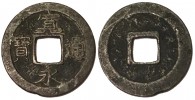
Japan. Tokugawa Shogunate. Shin-Kanei Tsuho (new Kanei Tsuho). Akita-senHartill 4.167-8 var. esp. 4.167; Jones (2007) 243; KM C 1.1 var; Zeno # 252731
1 mon (cast copper alloy), cast 1738-1750 (Genbun 3 - Kanen 3) at the Kawajiri-mura, Akita mint (Dewa Province); called Akita-sen/Taiji; 2.91 g., 23.51 mm. max.
Obv: å¯æ°¸é寶 Kanei tsuho
Rev: Blank
Hartill and Jones list two varieties of Akita-sen, although there are apparently at least five. This is the variety Akita-sen are distinguished by the hooked feet of 寶 ho. This variety has larger characters and a é tsu with a knotted radical.
Hartill rarity VCStkp
|
|
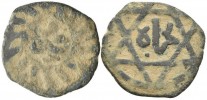
Mamluk (Bahri). Anonymous (741-743 A.H. = 1341-1342 A.D.)Balog --; SNAT Hamah 398-409; Album 931H
AE fals; Hamah mint, undated; 2.72 g., 20.71 mm. max., 0°
Obv.: Double circular line, connected with spokes within border of dots. öñè (=duriba/struck) in center.
Rev.: Circular line border, linear hexagram within. èÃÂÃâ¦Ã§Ã© (=bi-Hamah) in center.
The death of Muhammad I in June 1341 was followed by a period of political instability. Muhammad designated his son Abu Bakr as his successor, but Muhammad's senior aide, Qawsun, who held real power, executed Abu Bakr after just two months as sultan. Qawsun had Muhammad's infant son, Kujuk (age 8 or 9), enthroned, but within six months, Qawsun and Kujuk were toppled. Kujuk's half-brother, Ahmad I, was declared sultan. Ahmad relocated to al-Karak, leaving a deputy to rule in Cairo. He was deposed after just five months, and replaced by his half-brother Isma'il in June 1342. In light of the chronology assigned to this coin by the SNAT, it could conceivably have been issued late in the third reign of Muhammad or early in the reign of Isma'il. It could also conceivably have been issued by one of Isma'il's three predecessors. However, according to the Table of Mint Activity in Balog, none of them issued copper coins from the Hamah mint.Stkp
|
|

Huszár 549, Pohl 91, Unger 438, Réthy II 90 Hungary. Louis I (Lajos I, in Hun.) (1342-1382). AR obol, .20 g.
Obv: + REGIS LODOVICI, Patriarchal cross.
Rev: Saracen head left.
All catalogs refer to the Saracen-head side of this emission as the reverse, although Pohl displays that side to the left (where the obverse is traditionally displayed) for consistency of presentation.
Struck 1373-1382 (per Huszár, Pohl & Unger, although Huszar later wrote that the Saracen-head coinage incepted in 1372) in an unidentified mint by an unknown moneyer (per Pohl).
Huszár/Pohl rarity rating 7.
The Saracen's head is a pun on the surname of Jacobus Saracenus (Szerechen, in Hun.) and his brother, Johannes, courtiers of Italian descent who were ennobled by Louis. The image of a Saracen's head appeared on their coat of arms. Jacobus became the kammergraf at the Pécs mint in 1352, and the Comes Camerarum Regalium in 1369. He died in the early 1370s, at which time Johannes succeeded him as kammergraf.
Stkp
|
|
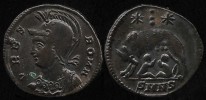
Urbs Roma NicomediaRIC VII Nicomedia 195
Nicomedia mint, second officina, struck under Constantine I, 330-335 A.D.
AE3, 18 mm.
Obv: VRBS ROMA, helmeted plumed bust or Roma left, wearing imperial cloak
Rev: She-wolf standing left (___ on shoulder), suckling the twins (Romulus and Remus), two stars above, three vertical pellets at center between them, SMNS in exergue
RIC rarity r1
Stkp
|
|

Anonymous 12th Century Class I. Huszár 103, Toth-Kiss 18.13.1.2 sigla a2.5/13; Unger 53 var. (wedges), Réthy I 90 var. (wedges)/Zimmerman 12., Frynas H.11.11b, Lengyel 17A, Adamovszky A109Anonymous 12th Century Class I; attributed to Béla II (1131-1141) by Lengyel and tentatively attributed to him by Unger, Frynas and Adamovszky, but this attribution is not accepted by Huszár and Toth-Kiss.
AR denar (average: .36 g., 12.0-12.5 mm.),, .34 g., 12.63 mm. max.
Obv: Lines and the letter E instead of a legend, cross with circle at its center, pellets within arms of the cross.
Rev: Lines instead of a legend, cross without wedges.
Huszár rarity R1, Toth-Kiss rarity 30, Unger rarity --, Frynas rarity --.Stkp
|
|

Huszár 605, Pohl 141-6 Unger 470f, Réthy II 141Hungary. Wladislaus I (Ulászló in Hun.) (1440-1444). Billon denar, 16 mm.
Obv: * MOnETA ⢠WLADISLAI ⢠DEI ⢠GRA, Polish eagle facing left.
Rev: * REGIS ⢠VnGARI ⢠ET ⢠CETERA, Crowned two-part shield (Ãrpádian stripes and patriarchal cross), BâP (privy mark) in fields.
The type was struck in 1442 (per Pohl, Huszár & Unger). This privy mark was struck in Buda (now Budapest) (per Pohl).
Huszár/Pohl rarity rating 5. The obverse and reverse legends depicted and described in Huszár and Pohl differ from the legends depicted and described in Unger and Réthy. To the extent that the legends on this coin can be discerned, it appears to conform to Huszár and Pohl.
âOwing to inner strife and disordered general conditions, the coins [of this period] were usually minted with extremely low precious metal content; moreover, poor mintages were often struck with negligently engraved dies. As a result of the hurried, superficial minting, it was sometimes doubtful whether a faulty coin had been issued officially, or was a forgeryâ (Huszár 1963).
Stkp
|
|
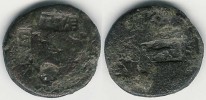
Augustus (Gaius Julius Caesar Octavianus) (27 B.C. ââ¬â 14 A.D.) and Tiberius (Tiberius Julius Caesar) (14-37 A.D.) or Caligula (Gaius Julius Caesar Augustus Germanicus) (37-41 A.D.)Martini-Pangerl 90 (re TIâ¢CÃ), 75 & 83 (re AVG), 98 (re helmet), 95-97 (re dolphin)
AE 23-26 mm
Obv: TIâ¢CÃ, AVG and helmet countermarks on an unidentified undertype.
Rev: Dolphin countermark on an unidentified undertype.
The TIâ¢Cà countermark is late Augustinian and is often combined with the dolphin and helmet countermarks. The AVG countermark is probably associated with Tiberius or Caligula.
From an uncleaned coin lot.Stkp
|
|

Schjöth --, Hartill Type 2.2 (QC) 11.4-5 and (CCC) 22.104, KM --Kangxi (1662-1722)
1 cash (cast brass), 1695 [?]-1703 [?], Guangdong Province, Guangzhou mint,3.33 g., 24.07 mm.
Obv: Kangxi tongbao.
Rev: Guwang (in Manchurian) to the left, guang (in Chinese) to the right.
Type 2 is comprised of coins with a two dot tong and a nominal weight of 1 qian (= 3.73 grams) and a diameter under 26 mm. They are red copper.
This is one of a series of twenty coins known as âpoemâ coins (shi qian), which, according to folklore, have talismanic qualities when placed together. The coins were put in a specific order in which the mint names formed a âpoem.â The poem did not have a particular meaning, but rhymed according to the rules of classical Chinese poetry.
Hartill rarity 8 (QC) and 15 (CCC).Stkp
|
|
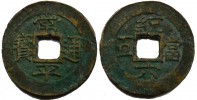
Korea. Yi Dynasty. Sang Pyong Tong Bao. Tongwiyong/Military Office in SeoulMandel/Velde-Hartill 30.31.6; KM 763.6; Zeno # 262900
AE 5 mun; cast 1883 by the Tongwiyong/Military Office in Seoul; sixth series; 11.30 g., 31.71 mm.
Obv: 常平é寶 Sang Pyong Tong Bao
Rev: çµ± Tong above; ç¶ Tang (equal to) to right; äº O/5 to left; å
Yuk/6 below
Large characters; two-dot é tong, one hook in å¹³ Pyong
Velde-Hartill rarity: CommonStkp
|
|
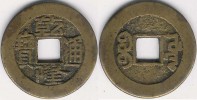
Schjöth 1466 var., Hartill (QC) 6.68 & (CCC) 22.257 Type F1, KM 390 var.Qianlong (1736-1795)
1 cash (cast brass), 1774 [?], Board of Works mint (in Beijing), 23 mm.
Obv: Qianlong tongbao.
Rev: Boo yuwan.
Type F coins have a Z yi, the Y- of yuwan is horizontal, a slanting gan, and a diameter around 23 mm. Type F1 coins have a distinctive curved head tong and a round head boo.
Hartill rarity 10 (QC) and 15 (CCC).Stkp
|
|
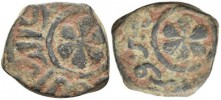
Mamluk (Bahri). Isma`il (al-Salih `Imad al-Din Isma`il) (743-746 A.H. = 1342-1345 A.D.)Balog 291 Plate XII 291a-b; Album 935
AE fals; Halab/Aleppo mint, dated 743 A.H. = 1342/3 A.D.: 2.67 g., 18.29 mm. max.
Obv.: Circular line border. Counter-clockwise marginal legend: اÙسÙطا٠اÙÙ
Ù٠اÙصاÙØ Ø¹Ù
اد اÙدÙÙا ÙاÙدÙÙ (= al-Sultan al-Malik al-Salih Imad al-Din waldiyn), six-petaled rosette in center.
Rev.: Circular line border. Counter-clockwise marginal legend: ضرب بØÙب سÙØ© Ø«Ùاث ÙاربعÙÙ ÙسبعÙ
اÙØ© (= duriba bi-Halab sanat thlath wa'arbaein wasabeimaya = Struck in Halab in the year 743).
Isma'il was the fourth son of Muhammad I to succeed their father. Under his orders or those close to him, his two surviving predecessors and brothers, Kujuk and Ahmad, were killed. He was 17 upon his accession and died of natural causes at age 20. During his short reign, a level of political stability was restored. He was deemed by Mamluk-era historians to be the best of Muhammad's sons and referred to as the renewer of the Islamic faith in the sultanate.Stkp
|
|

Ottoman Empire. Bayezid I Yildirim (âthe Thunderboltâ) (791-805 A.H. = 1389-1402 A.D.)Album 1291, Sreckovic I 3.
AR akche dated 792 A.H. = 1390 A.D. (immobilized date), no mint, 13.5-15 mm.
Obv: Bayezid bin / Murad [= Bayezid son of Murad], in two lines within circle, divided horizontally by a straight line.
Rev: Hullide Mülkehn [May his kingdom flourish] /sene [= year] / 792, in three lines within circle and pearl border, with the second line designed as a divider line.Stkp
|
|

The Montefiore Hebrew Orphans Home (Montreal, Quebec, Canada)AE token, undated (1936), 33.4 mm., 10.87 gr., 180°.
Obv: THE GREAT DOLLAR DRIVE FOT THE MONTEFIORE H, O. HOME, around toothed rim, LUCKY -- DOLLAR to left and right of building in center, 1650 JEANNE MANCE ST. AND MONTREAL below building.
Rev: CONTRIBUTION and ONE DOLLAR along toothed rim, HELP US/AND/GOD/WILL/HELP YOU between busts of boy and girl.
Ref: Unknown.
Note: The Montreal Hebrew Orphansâ Home opened in 1909 on 18 Evans Street. In 1921, the home was forced to relocate to larger facilities at 500 Claremont Avenue. The Montefiore Orphans' Home, originally located on Jeanne Mance Street, opened in 1918. This second home merged with the Montreal Hebrew Orphansâ Home in 1936, and relocated to the former Herve Institute building on Claremont Avenue. In 1942 the orphanage was forced to close due to lack of funding and the rise of foster care in Quebec.Stkp
|
|

Vietnam (Dai Nam). Minh Mạng (1820-1841).Barker 101.17, KM 182b, C 81.3, Toda 228 var..
3 phan (cast copper alloy), 21 mm.
Obv: Minh Mạng thong bao (closed minh, closed bei, thong head flat; smallest characters).
Rev: blank.Stkp
|
|

Julian II, The Apostate (Caesar, 355-360 A.D.; Augustus, 360-363 A.D.) (Flavius Claudius Julianus)RIC VIII Cyzicus 130
AE3, 20.5 mm, die orientation 0°
Cyzicus mint, first officina, struck 361-363 A.D.
Obv: D N FL CL IVLIâANVS P F AVG, pearl-diademed, helmeted and cuirassed bust left, holding spear in right hand and shield in left hand.
Rev: VOT / X / MVLT / XX in four lines within wreath, CVZA in exergue.
RIC rarity s
Stkp
|
|

Vietnam. Later Lê Dynasty. Lê TÆ°Æ¡ng Dá»±c (1510-1516). Há»ng Thuáºn Thông BảoBarker 39.20; Toda 61; Zeno # 307260
Bronze 1 van; 4.00 g., 24.91 mm. max.
Obv: æ´ªé é寶 Há»ng Thuáºn Thông Bảo
Rev: plain
Mixed dots and curly-stroke variety with top dot of æ´ª Há»ng not connected
Barker rarity 5Stkp
|
|
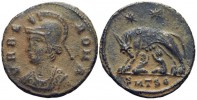
Urbs Roma ThessalonikaRIC VII Thessalonika 187 var. (shoulder mark)
Thessalonica mint, fifth officina, struck under Constantine I, 330-333 A.D.
AE4, 1.44 g., 16.82 mm. max., 180°
Obv: VRBS ROMA, helmeted plumed bust of Roma left, wearing imperial cloak.
Rev: She-wolf standing left, wreath on shoulder, suckling the twins (Romulus and Remus), two stars above, SMTSE in exergue.
RIC rarity R4 Stkp
|
|

Huszár 719, Pohl 221-2, Unger 565c, Réthy II 239A Hungary. Matthias "Corvinus" (Mátyás Hunyadi in Hun.) (1458-1490). AR denar, 16 mm.
Obv: + M ⢠MAThIE ⢠R ⢠VnGAR, Four-part shield with Hungarian arms (Ãrpádian stripes, patriarchal cross, Dalmatian leopard heads, crowned lion of Beszterce), raven in escutcheon.
Rev: PATROnA â VnGARI, Crowned Madonna with infant Jesus to her left, Kârosette (privy mark) in fields.
The type was struck 1482-1486 (per Huszár & Unger) or 1479-1485 (per Pohl), with an average fineness of approximately .500 silver, and an average weight of .59023 g. This privy mark was struck in Kremnitz (formerly Körmöcbánya, Hungary, now Kremnica, Slovakia) by Paul Peck, kammergraf.
Huszár/Pohl rarity rating 3. This is a common privy mark, appearing on around 20% of the coins of this type.
Stkp
|
|

Sultanate of Palembang Darussalam; Muhammad Bahauddin (1776â1803)Robinson 9 var. (no pellets); Millies 192 var.; Zeno # 280676
Tin piti dated 1203 A.H. = 1789 (minted under Sultan Muhammad Bahauddin [1776â1803]); .61 g., 18.41 mm. max.
Obv.: Al-sultan fi bilad Palembang sanat 1203 (= The sultan of Palembang year 1203)
Rev. Blank
Robinson rarity R1, but variety without pellets not listed in Robinson.Stkp
|
|

Schjöth ----, Hartill (QC) 14.34 Type 1.d, Hartill (CCC) 22.1346, KM C 11-9.3GUANGXU (1875-1908)
1 cash (cast brass), 1898-1905 [?], Henan Province (in Kaifeng), 21.5 mm.
Obv: Guangxu tongbao.
Rev: Boo he, crescent above the hole.
Type 1 is comprised of coins with a fou bao, a six stroke bei, and a closed head, one dot tong. They have a nominal weight of 0.7 qian (= 2.611 gr.).
Hartill (QC) rarity 9Stkp
|
|

Anonymous 12th Century Class III. Huszár 148; Toth-Kiss 20.6.1.1 sigla b1.15/47; Unger 69; Réthy I 126; Frynas H.12.15; Lengyel 12/17; Adamovszky A122.Anonymous 12th Century Class III; attributed to Géza II (1141-1162) by Lengyel and tentatively attributed to him by Unger, Frynas and Adamovsky, but this attribution is not accepted by Huszár and Toth-Kiss.
AR denar (average: .19 g., 12.5 mm.), .25 g., 11.46 mm. max.
Obv: Four dots and four crescents containing crosses around central cross; border of dots.
Rev Kufic ornaments comprised of line below cross, diagonal lines ending in pellets to sides of cross, U-shape below, linear border.
Struck in Esztergom.
Huszár rarity 9, Toth-Kiss rarity 40, Unger rarity 28, Frynas rarity N.Stkp
|
|
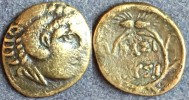
Kingdom of Thrace. Lysimachos (323-281 B.C.)Sear 6822; Müller pl. XLII, 14; SNG Copenhagen 1168-1169.
AE unit, Kallatis (now Mangalia, Romania) mint, ca. 297-281 B.C. or Lysimacheia (now Eksemil, Turkey) mint, 1.15 g., 14.13 mm. max., 0°
Obv.: Head of young Herakles right, wearing lion skin headdress.
Rev.: BAãI / ÃâºYãI in two lines within a wreath of grain.
Lysimachus, one of Alexander the Great's personal bodyguards, was appointed strategos in Thrace and the Chersonesos after Alexander's death. In 309 B.C. he founded his capital Lysimacheia and in 306 B.C. he followed the example of Antigonus in taking the title of king, ruling Thrace, Asia Minor and Macedonia. In 281 B.C. he was killed in battle against Seleucus.Stkp
|
|

Schjöth 1469, Hartill 9.13 Type CP2.2, KM 400Qianlong (1736-1795)
1 cash (cast brass), 1750s [?] -1790s [?], Fujian Province (in Fuzhou), 24 mm.
Obv: Qianlong tongbao.
Rev: Boo fu.
This is a Coastal Province Type Coin.
Hartill rarity 10Stkp
|
|

Huszár 846, Pohl 258-2, Unger 675e, Réthy II 308A, dated 1524 Hungary. Louis II (Lajos II in Hun.) (1516-1526). AR denar, 16 mm.
Obv: 1524, with rosettes on either side of date, above four-part shield with Hungarian arms (Ãrpádian stripes, patriarchal cross, Dalmatian leopard heads, Bohemian lion), Polish eagle in escutcheon, rosette between two annulets on sides of shield.
Rev: Crowned Madonna with infant Jesus to her right, LâK (privy mark) in fields.
The type was struck 1521-1525 (per Huszár) or 1521-1526 (per Pohl & Unger). This privy mark was struck in Kremnitz (formerly Körmöcbánya, Hungary, now Kremnica, Slovakia) (per Pohl).
This type was an inflationary currency that was referred to by contemporaries as âmoneta nova.â On average, 400 denars, each weighing 0.49 g., were struck form Ofner mark of silver with a fineness of 0,250 (per Huszár). They were officially valued at ½ a denar, but the public did not accept them at this overvalued rate (per Huszár & Pohl).
Huszár/Pohl rarity rating 4. Stkp
|
|
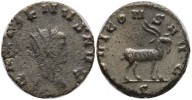
Gallienus (Publius Licinius Egnatius Gallienus) (253-268 A.D.)SRCV 10236, RIC V S-207, Göbl 731b, Van Meter 100
BI Antoninianus, 3.22 g., 19.26 mm. max., 0°
Rome mint, sixth officina, tenth emision, struck during solo reign (260-268 A.D.), in 267-268 A.D.
Obv: GALLIENVS AVG, radiate head right.
Rev: IOVI CONS AVG, goat standing right, Ãâ (stigma) in exergue.
Issued in 267-268 A.D. to commemorate vows to Diana invoking his protection against the revolt of Aureolus.
RIC rarity C, Van Meter VB1.Stkp
|
|

Japan. Tokugawa Shogunate. Shin-Kanei Tsuho (new Kanei Tsuho), Genbun-sen/TaijiHartill 4.165-6 var., esp 4.165; Jones (2007) 241-2 var; KM C 1.1 var; Zeno # 250805
1 mon (cast copper alloy), cast 1737-1739 (Genbun 2-4) at Kameido-mura Edo mint (Musashi Province); 2.45 g., 23.64 mm. max.
Obv: Kanei tsuho (tiger tail kan; cursive dot on ei; square head and pointed tsu radical; hooked feet on ho; large characters).
Rev: Blank.
This series is known as Genbun-sen after the nengo (era name) in which it was cast. There are three varieties, but Hartill and Jones show just two. The characteristics are a tiger tail å¯ kan, pointed é tsu radical and hooked feet on 寶 ho. This is the variety with larger characters and just the left foot hooked, called taiji.
Hartill rarity VC
Stkp
|
|
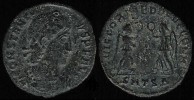
Constantius II (Flavius Julius Constantius) (Caesar, 324-337 A.D.; Augustus, 337-361 A.D.)RIC VIII Thessalonica 99
AE4, 15 mm.
Thessalonica mint, fourth officina, struck ca. 347-348 A.D.
Obv: CONSTANTI-VS P F AVG, laurel and rosette diademed, draped and cuirassed bust right.
Rev: VICTORIAE DD AVGG Q NN, two Victories standing facing each other, each holding a wreath and palm-branch, ⢠in center, SMTSÃâ in exergue.
RIC rarity c2
Stkp
|
|
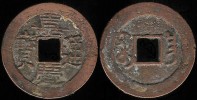
Schjöth 1507, Hartill (QC) 18.17 Type 2, KM 476.1Jiaqing (1796-1820)
1 cash (cast brass), 1806 [?] â 1820 [?], Jiangxi Province (in Nanchang), 25 mm.
Obv: Jiaqing tongbao.
Rev: Boo chang.
Type 2 is comprised of coins with a six stroke open bei and a long thin tong, per the Board of Revenue Type B1 (cf. Schjöth 1489, Hartill (QC) 5.153, KM 440.1).
Hartill rarity 10Stkp
|
|

Tye 14.1, Deyell 45Shahis (ca. 850-1,000 A.D.). AR jital, possibly Ohind mint, average silver content ca. 69%, average weight 3.3 g., 18 mm.
Obv: Recumbent bull facing left, trishula on its rump, Sri Samanta Deva, in Nagari script, above.
Rev: Horseman bearing lance facing right, Bhi above to left and Ma [?] above to right, both in Nagari script.
Tye rarity rating Abundant.
The history of the Shahi dynasties is almost unknown. The Hindu Shahi dynasty succeeded an earlier Buddhist Shahi dynasty, and was founded in 870 A.D. by Kallar, a Brahmin vazir to the last Buddhist king. The kingdom included portions of Kabulistan (the eastern territories of Greater Khorasan centered around Kabul, now in Afghanistan) and the old province of Gandhara (now in northern Pakistan), with capitals at Kabul and Ohind (in Gandhara). They lost Kabul to the Saminids around 988 A.D. and lost Ohind to Mahmud of Ghazni around 988 A.D. The coins bearing the legend Sri Samanta Deva (= Lord Feudatory Chief) were issued further east and later (albeit, with overlap) than those bearing the legend Sri Spalapati Deva (= Lord Commander of the Army).Stkp
|
|

Hungary. István/Stephen V (1270-1272). Huszár 355, Toth-Kiss 23.12.1.1, Unger 266, Réthy I 295, Lengyel 18/68, Frynas 19.11, Adamovszky 440Hungary. István/Stephen V (1270-1272) per Huszár, Toth-Kiss, Unger, Réthy, Frynas, Adamovszky and Gyöngyössy; and Béla IV (1235-1270) per Lengyel
AR denár (average .54 g., 12.2 mm.); .53 g., 12.45 mm. max., 0°
Obv: + MONETA ⢠VNGARIE, cross with circles between its arms.
Rev: Sphinx facing right with sword and shield.
Toth-Kiss list 18 denarii (exclusive of varieties) issued by István and Lengyel lists 14. Given that he ruled for only 27 months (May 3, 1270 to August 6, 1272) the number of emisions cannot be explained by the annual renewal and replacement of the coinage. However, István assumed the governance of the eastern part of the country as duke in 1257, in 1258 became the ruler of South-Styria, and in 1262 forced his father to enlarge his territory and adapted the title Younger King. According to Hóman (1916 p. 217) István had the right, as duke, to issue coins. It is likely that most of the coins issued by him date to before he assumed the kingship in 1270.
Huszár rarity 9, Toth-Kiss rarity 50, Unger value 30 DM, Frynas rarity NStkp
|
|
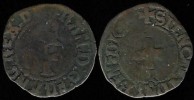
France (Royal). Francis I (1515-1547)Billon (179 parts per million AR) liard (valued at 3 deniers tournois). Struck 1541 in Limoges. .81 g., 16.51 mm. max., 0°
Cianni 1181, LaFaurie 790, Duplessy 930, Sombart 4290, Roberts 3331
Obv.: + FRAN : D : G : FRANC : REX : D . . . (pellet under 2nd N [10th letter], signifying Limoges), crowned F.
Rev.: + SIT : NOMEN DNI : BENEDIC . . . (= Blessed be the name of the Lord) (pellet under 2nd N [10th letter], signifying Limoges), cross with I (= Limoges mintmark) beneath.Stkp
|
|

Urbs Roma CyzicusRIC VII Cyzicus 118
Cyzicus mint, fourth officina, struck under Constantine I, 335-336 A.D.
AE3, 18 mm.
Obv: VRBS ROMA, helmeted bust or Roma left, wearing imperial cloak
Rev: She-wolf standing left, suckling the twins (Romulus and Remus), two stars above, *SMKÎ in exergue.
RIC rarity r5
Stkp
|
|

Huszár 566, Pohl 112-1, Unger 442a, Réthy II 114, Frynas 26.5, Toma plate I/1
Hungary. Mária/Maria (1382-1387 solo reign; 1387-1395 with husband Zsigmond/Sigismund of Luxembourg)
AR denar; .49 g., 15.02 mm. max., 270°
Obv: + mOnETA mARIE [Gothic-style letters A], Patriarchal cross
Rev: + REGInE VnGARIE [Gothic-style letter A], Crowned M
The type was struck in only in 1383 (per Huszár, Unger and Frynas) or from 1383 through 1385 (per Pohl). It is traditionally viewed as the second of three denarii struck by Mária (after Huszár 565 and before Huszár 569). More recently, it has been viewed as Mária 's third type (per Gyöngyössi and Toma), struck in 1386-1387, ending when Zsigmond's coinage began (per Gyöngyössi). This coin, struck without a privy mark in the reverse fields, was probably struck in Buda (per Pohl).
Toma notes twelve legend variations among 456 coins of this type in the Cluj-MÃÆnÃÆÃ
Ÿtur Hoard, found in Cluj-Napoca, Romania (formerly, Kolozsvár, Hungary), in 1934 (but lists only eleven). They differ mainly in terms of completeness of legends, presence of pellets, and the styles of the letter A. Toma lists three variations among 302 coins struck in Buda (Pohl 112-1). The legends on this coin are as per Toma 1. Toma notes 260 coins with this combination.
Toma further notes three versions of the patriarchal cross and eight versions of the crowned M. There are fourteen obverse/reverse design combinations appearing among 411 coins from the hoard, all of which are listed by Toma as being among 271 Buda issues (Pohl 112-1). The cross on this coin is apparently Toma B (wide cross with split ends), which is linked to Toma's crowned Ms a-d; the crowned M appears to be Toma c. Toma notes 96 coins with the B/c combination.
Huszár/Pohl rarity rating 5; Frynas rarity C. The legend combination appearing on this coin is depicted/described in Unger, Réthy and Frynas. The legend combination depicted/described in Huszár and Pohl differs in that there are pellets between words on the obverse and reverse.Stkp
|
|
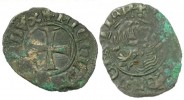
Italian States. Venice. Republic. Stahl 12-13, CNI VII, p. 106, 18-19, 27; Papadopoli, p. 221, 4.
Billon tornesello, struck under Doge Michele Morosini, (June 10 to October 16, 1382), .63 g., 17.3 mm. max., 90° (clashed dies).
Obv: â¢+⢠MIChL M[AVRO]C DVX, central cross pattée.
Rev: + ⢠V[EXIL]IFER ⢠VEN[E]TIAï,, winged lion of St. Mark, seated facing, holding a book
Michelle Morosini died of the plague just four months after becoming dodge. Torneselli minted in his name are rare; the Chalkis Hoard contained just 26 specimens out of a total of 4,806 coins. By contrast there were 789 coins of his immediate predecessor and 2,629 of his immediate successor.
ex Chalkis Hoard, ex Alex G. Malloy, ex Forum Ancient Coins.Stkp
|
|

Anonymous 12th Century Class I. Huszár 89; Toth-Kiss 18.5.1.1 sigla c2.7/55; Unger 48; Réthy I 74; Frynas H.11.6; Lengyel 11/9; Adamovszky A97Anonymous 12th Century Class I; attributed to Béla II (1131-1141) by Lengyel and tentatively attributed to him by Unger, Frynas and Adamovszky, but this attribution is not accepted by Huszár, Toth-Kiss and Gyöngyössy.
AR denar (average: .23 g., 10.0-10.5 mm.), .19 g., 10.88 mm. max.
Obv: Cross with pellets in the angles in frame of four crescents and four crosses.
Rev: Lines instead of an inscription, cross with four wedges.
Struck in Esztergom.
Huszár rarity 7, Toth-Kiss rarity 20, Unger rarity 8, Frynas rarity C.Stkp
|
|

France. Jeton of Louis XIVFeuardent 12936
Brass Jeton, issued ca. 1662 during the reign of Louis XIV (1643-1715), 4.28 g., 26.05 mm. max., 180°
Obv: LVDOVICVS ⢠-- ⢠MAGNVS REX â¢, Bust of Louis XIV facing right.
Rev: SINE ⢠CRIMINâ¢E ⢠CESSI ⢠(=I Rule Flawlessly), Eagle with wings spread facing left, holding a thunderbolt, two scrolls in exergue.Stkp
|
|
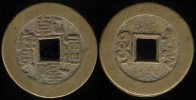
Schjöth 1464, Hartill 5.98 Type F (QC) & 22.215 Type F1 (CCC), KM 387.1Qianlong (1736-1795)
1 cash (cast brass), 1774 [?], Board of Revenue mint (in Beijing), east branch, 23 mm.
Obv: Qianlong tongbao.
Rev: Boo chiowan.
Type F is comprised of coins with a hook yi, a square head tong (except for the west branch) with a straight radical, a round head boo, chiowan in cursive style, a slanting gan (except for the south branch), and a diameter around 23 mm. The east branch coins have a six stroke bei.
Hartill rarity 11 (QC) & 15 (CCC).Stkp
|
|
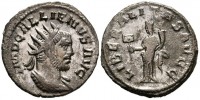
Gallienus (Publius Licinius Egnatius Gallienus) (253-268 A.D.)SRCV 10277 var. (0bverse legend) , RIC V J-444, Göbl 1601b, Van Meter 148
BI Antoninianus, 3.50 g., 20.82 mm. max., 180°
Antioch mint, 5th emission, struck during joint reign (253-260 A.D.), in 256-257 A.D.
Obv: IMP GALLIENVS AVG, radiate cuirassed bust right.
Rev: LIBERALITAS AVGG, Liberalitas standing left, holding cornucopia right and counting-board/tessera left.
Liberalitas is the personification of generosity, and frequently alludes to a specific imperial donative to the urban population of Rome. On this emission, it refers to the donative of 255 A.D. to mark the joint consulate of Gallienus and Valerian.
RIC rarity C, Van Meter VB1.Stkp
|
|

Mamluk (Burji). Barquq (al-Zahir Sayf al-Din Abu Sa`id Barquq) (1st reign 784-791 A.H. = 1382-1389 A.D.; 2nd reign 792-801 A.H. = 1390-1399 A.D.)Balog 562 Plate XXIII 562; SNAT Damascus __; Album 975
AE fals; Dimashq/Damascus mint, dated 790 A.H.? = 1388 A.D.? (1st reign); 2.63 g., 17.92 mm. max., 270°
Obv.: Apparently no border. اÙسÙطا٠/ اÙÙ
Ù٠اÙظاÙر / اب٠سعÙد سÙÙ / اÙدÙÙا ٠اÙدÙÙ (al-Sultan / al-Malik al-Zahir / Abu Sa'id Sayf / ______) in center; Clockwise marginal legend اÙدÙÙا ٠اÙدÙ٠ضرب بدÙ
ش٠سÙØ© ثسعÙÙ ÙسبعÙ
اÙØ© (= ___________ duriba bi-Dimashq sanat thaseayn wasabeimaya = ________ struck in Damascus in the year 90)
Rev.: Solid linear border. Circle of big dots, برÙÙÙ (= Barquq) in center.
Barquq, who was of Circassian origin and acquired as a slave, became the first sultan of the Mamluk Burji dynasty. A member of the faction behind the throne during the reigns of Sha'ban II's young sons, 'Ali II and Hajji II, Barquq consolidated power and siezed the throne in 1382. He was deposed in 1389 and Hajji restored as sultan. By early 1390, Barquq reclaimed his title. During his second reign, the Mongol warlord Timur invaded and defeated the Mamluks at Damascus and sacked it along with Aleppo in 1399.
Attribution courtesy of altaycoins and Alex Koifman.Stkp
|
|
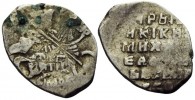
Russia. Mikhail Fyodorovich Romanov (1613-1665)Grishin-Kleishnikov 338 (Knight die 1, text die 10), Group I
AR wire kopek; Moscow mint, struck 1614. .49 g., 12.46 mm. max., 180ââ¦
Obv: Horse rider with spear, MOC / [KBA] (=Moscow) below.
Rev: Cyrillic legend in six lines, æàì-I[BE] / Ãâº-KIKÃËS[ì] / ÃÅÃËÃ¥ïI[ÃâºO-ä] / EÃâÞ[POBIç] / ì-BCEæ-P[W] / ⢠C[IÃË] (Czar and Grand Prince Mikhail Fyodorovich of all Russia).Stkp
|
|

Japan. Tokugawa Shogunate. Shin-KaneiTsuho (new KaneiTsuho). Bunsei-senHartill 4.255; Jones (2007) 297; KM C 4.1; Zeno # 333486
4 mon (reddish copper alloy); cast in 1821-1825 at the Asakusa mint, in Musashi Province. 5.37 g., 28.31 mm. max., 0°
Obv.: å¯æ°¸é寶 Kan Ei Tsu Ho (= Kanei era standard currency), drooping ei and tsu radical.
Rev.: Eleven nami/waves
Hartill rarity C
Attribution per Nijigaoka, on Zeno.ruStkp
|
|

Huszár 580, Pohl 119-8.2, Unger 451o, Réthy II 125AHungary. Sigismund (Zsigmond, in Hun.) of Luxembourg (1387-1437; Holy Roman Emperor 1433-1437). AR parvus, 10 mm.
Obv: Four-part shield (Ãrpádian stripes and eagle), SâVâR above and flanking, h to the right of the S (privy mark).
Rev: Cross with four crowns between its arms.
The type was struck in 1387-1427 (per Pohl, Huszár & Unger, although this emission terminated in 1410 per Engel) at Nagyszeben, in Transylvania (Hermannstadt, in German, which is why the privy mark is an âhâ; now, Sibiu, Romania) (per Pohl).
Huszár/Pohl rarity rating 4.
The parvus (also called the âsmall denarâ fillér or pankart) was struck with an average nominal fineness of 0.353 silver. Because of many worn out and counterfeit coins it was pulled from circulation after 1427 (per Huszár). Although not specifically discussed in this context in Engel, the parvus must have experienced the same rampant debasement as the denar did.
âOwing to inner strife and disordered general conditions, the coins [of this period] were usually minted with extremely low precious metal content; moreover, poor mintages were often struck with negligently engraved dies. As a result of the hurried, superficial minting, it was sometimes doubtful whether a faulty coin had been issued officially, or was a forgeryâ (Huszár 1963, at 15). This emission is typically struck on a small flan.Stkp
|
|

Huszár 547, Pohl 89-5, Unger 432f, Réthy II 89ALouis I (Lajos I, in Hun.) (1342-1382). AR denar, 14 mm., .28 gr.
Obv: + MOnETA LODOVICI, Saracen head left.
Rev: + REGIS hVnGARIE, Patriarchal cross with random pellets, lilyâlily (privy mark) in fields beneath cross-arms.
The type was struck 1373-1382 (per Huszár, Pohl & Unger, although Huszár later wrote that the Saracen-head coinage incepted in 1372). This privy mark was probably struck at Kassa (now Košice, Slovakia) by an unidentified moneyer (per Pohl).
Huszár/Pohl rarity rating 3.
The Saracen's head is a pun on the surname of Jacobus Saracenus (Szerechen, in Hun.) and his brother, Johannes, courtiers of Italian descent who were ennobled by Louis. The image of a Saracen's head appeared on their coat of arms. Jacobus became the kammergraf at the Pécs mint in 1352, and the Comes Camerarum Regalium in 1369. He died in the early 1370s, at which time Johannes succeeded him as kammergraf.Stkp
|
|

Japan. Tokugawa Shogunate. Shin-Kanei Tsuho (new Kanei Tsuho). Takatsu-senHartill 4.197-200 var.; Jones (2007) 270-2 var; KM C 1.8 var; Zeno # 250808
1 mon (cast copper alloy), cast from 1741 (Kanpo 1), at the Takatsu Osaka mint (Settsu Province); 1.97 g., 21.74 mm. max., 0°
Obv: å¯æ°¸é寶 Kanei tsuho
Rev: å
Gen
Although there are fifteen varieties, of which ten circulated, Hartill only lists four and Jones three. This is the variety called æ¥éå®èå
Sekkakuho Hai Gen in which the crown of 寶 ho touches the inside square hole. It is not listed in Hartill.
The å
gen character refers to the Gembun era, at the end of which (1740 = Genbun 5) the order to cast these cash was given. 200,000 strings a year were cast.
Hartill rarity VC-CStkp
|
|

Denmark. Christian IV (1588-1648)Hede 150, Schou 87, Sieg 53, KM 133.1
AR 4 skilling, 22 mm., dated 1645, struck by Heinrich Köhler at the Copenhagen mint
Obv: IIII ⢠SKILLING ⢠DANSKE, surrounding crowned monogram of Christian IV (4 within a C)
Rev: â¢â¢â¢ / IUSTUS / ×××× (Jehovah) / IUDEX / 16 filament-hook (privy mark) 45, in four rows
Note: In 1643, toward the end of the Thirty Years War, Sweden launched a surprise attack upon Denmark which is called the Torstensson War (after Swedish general Lennart Torstensson). King Christian IV had to rapidly obtain funds to pay his mercenary troops to defend the kingdom against the advancing Swedes. Being short of funds, the emissions that are referred to as âhebræermønterâ were issued with a reduced silver content; the silver content of the 4 skilling coin was reduced from .8500 fineness to .2500 (the king later pawned his royal crown and ordered that silver furniture from Frederiksborg Castle be melted to fund the war). Outraged over Swedenâs unannounced invasion, King Christian ordered that the coins bear a special reverse legend, in a mixture of Hebrew and Latin, which reads: âGod is a righteous judgeâ (Psalm 7:12).
Stkp
|
|
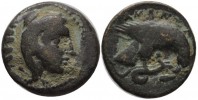
Macedonian Kingdom. Amyntas III (389-383 & 381-369 B.C.)Sear 1512, Westermark, Remarks Type 1; AMNG 7; SNG ANS 100-109; SNG Alpha Bank 214-230, BMC 17 ff.
AE tetrachalkon, 3.57 g., 16.15 mm. max., 270°
Struck ca. 381-369 B.C. at the Aigai or Pella mint.
Obv.: Head of Herakles right, wearing lion skin.
Rev.: Eagle standing right, devouring serpent, AMYNTA above.
Amyntas was the father of Philip II and grandfather of Alexander the Great. He is considered to be the founder of the unified Macedonian state.Stkp
|
|

Huszár 717, Pohl 216-13, Unger 562m, Réthy II 235A, Kaplan Subtype B Hungary. Matthias "Corvinus" (Mátyás Hunyadi in Hun.) (1458-1490). AR denar.
Obv: M MAThIE ⢠R VnGARE, Four-part shield with Hungarian arms (Ãrpádian stripes, patriarchal cross, Dalmatian leopard heads, Bohemian lion), raven in center.
Rev: PATROn â VnGARE, Veiled Madonna with infant Jesus to her right, nâcrossed hammers (privy mark) in fields.
The type was struck 1468-1470 (per Unger), 1468-1481 (per Huszár) or 1468-1484 (per Pohl), with an average fineness of approximately .500 silver, and an average weight of .59023 g.
Those with this privy mark were struck in Nagybánya (now Baia Mare, Romania) under a collective citizenry mark in 1470 (per Pohl).
Huszár/Pohl rarity rating 3. It is a highly variable type with four Subtypes. Subtype B is one of the more common, comprising around 30% of the coins in the emission. This is a common privy mark, appearing only on this subtype and on almost 30% of the coins of this type.
Subtype B coins lack a cross at the beginning of the obverse legend, which is M MAThIE ⢠R ⢠VnGARIE (or a minor variant), either lack an escutcheon or have just faint hints of one, and are without a ring in the raven's beak. They are neither described nor depicted in any of the catalogs.
The heads of the Madonna and infant Jesus tend to be angled to the right on coins of this type with this privy mark. They also display a differently styled letter A than all others of the type.
Stkp
|
|
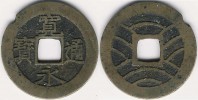
Japan. Shogunate.Hartill 4.253, Jones (1984) 205, Jones (2007) 295, KM C 4.2 var.
4 mon (cast copper alloy), from 1769 (Meiwa 11), Edo Fukagawa mint, 28 mm. This variety is known as fuei (looking down ei) because the second stroke of the ei character is slightly slanted down. There are subvarieities of fuei.
Obv: Kanei tsuho.
Rev: Eleven waves.
Kanei Tsuho coins were first cast in small quantities in 1626 in Mito, but in 1636, the Tokugawa government ordered that large quantities be cast, and distributed model coins to private subcontractors in locations throughout Japan. By the 1650âs 16 different locations were casting these coins. When the Kanei era ended in 1643 the legend was kept in use until the 1860âs. In the early 1700âs copper mines began to be exhausted in Japan and it gradually became too expensive to manufacture copper coins. In response, the government authorized the casting of iron coins in 1739. Copper alloy coins continued to be made but were frequently of less weight and lower quality. The Tokugawa government first commissioned a Kanei Tsuho coin valued at 4 mon in 1768. The first version was made at the Fukagawa mint in Edo and had a design of 21 waves on the reverse. In 1769 the design changed to have only 11 waves and all subsequent versions used the 11 wave design. It was not much larger than a 1 mon coin so it was cost effective to produce.
Attribution assistance courtesy of Eric Crawford and Diego M. SantosStkp
|
|

Huszár 717, Pohl 216-9, Unger 562i, Réthy II 235A, Kaplan Subtype A Hungary. Matthias "Corvinus" (Mátyás Hunyadi in Hun.) (1458-1490). AR denar.
Obv: + M MAThIE R VnGARIE, Four-part shield with Hungarian arms (Ãrpádian stripes, patriarchal cross, Dalmatian leopard heads, Bohemian lion), raven in center.
Rev: PATROn â VnGAR â¢, Veiled Madonna with infant Jesus to her right, K âshield (privy mark) in fields.
The type was struck 1468-1470 (per Unger), 1468-1481 (per Huszár) or 1468-1484 (per Pohl), with an average fineness of approximately .500 silver, and an average weight of .59023 g.
This privy mark was struck in Kremnitz (formerly Körmöcbánya,
Hungary, now Kremnica, Slovakia) by Johannes Constorfer, kammergraf, in 1469 (per Pohl).
Huszár/Pohl rarity rating 3. This is a highly variable type with four subtypes. Subtype A is the most common variety, comprising around 50% of the coins in the emission. This is a common privy mark, appearing only on this subtype and on around 33% of the coins of this type.
In Subtype A coins, the obverse legend is + M MAThIE.R.VnGARIE (or a minor variant), per Huszar and Pohl, but contrary to the description in Huszár, there is either no escutcheon or just faint hints of an escutcheon, and there is no ring in the raven's beak. They are depicted in Huszár/Pohl but not depicted in Unger or Réthy.
Stkp
|
|
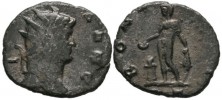
Gallienus (Publius Licinius Egnatius Gallienus) (253-268 A.D.)SRCV 10185 , RIC V S-470 var., Göbl 1391a, Van Meter 27 var.
BI Antoninianus, 1.71 g., 17.67 mm. max., 0°
Mediolanum mint, 3rd officina, struck during joint reign (253-260 A.D.), in 264-265 A.D.
Obv: [GALLIENV]S AVG, radiate head right.
Rev: BON [EVEN AVG], Bonus Eventus, nude, standing facing, head left, sacrificing from patera in right hand over lit altar, corn ears in left. MT in exergue.
Bonus Eventus, the god of good outcomes, was originally worshiped by the Romans as a deity especially presiding over agriculture and successful harvests. During the Imperial era, he was associated with other types of success. RIC describes the figure as Genius.
RIC rarity C, Van Meter VB1.Stkp
|
|

Vietnam (Annam). Later Lê Dynasty Thánh Tông (1442-1497)Barker 35.1-35.12; Toda 57
Bronze cash; cast during first nien-hao (1460-1470); 3.98 g., 24.66 mm.
Obv: Quang-thuan-thong-bao.
Rev: plain.
ex Forum Ancient CoinsStkp
|
|
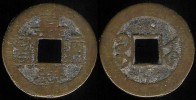
Schjöth 1504, Hartill (QC) 15.56 Type 3, KM 474.1Jiaqing (1796-1820)
1 cash (cast brass), 1806 [?] â 1820 [?], Hubei Province (in Jingzhou), 23 mm.
Obv: Jiaqing tongbao.
Rev: Boo u.
Type 3 is comprised of coins with a protruding head tong and a seven stroke bei. The top of u is a long stroke.
Hartill rarity 8Stkp
|
|

Elymais. Arsacid dynasty. Unidentified King (uncertain dates)van't Haaff 21.2.1-1 var. (pellets); de Morgan --; BMC plate XLII, 22-25; Sear GICV --; Alram --
AE unit (denomination undetermined), 1.73 g., 10.68 mm. max., 0°
Obv: Abstract bust facing right, details unclear.
Rev: Upturned crescent with dot above and below, all within wreath.
According to van't Haaff, too few of these coins are known to determine their denomination. Apparently, on the few coins that are known, too little detail on the obverse remains to obtain a complete description; the photo in van't Haaff is unclear. Those that are known to van't Haaff have three dots below the crescent and none above, although these coins appear as well with a single dot above and another below.
Attribution confirmation coutesy of Robert L3 (http://www.forumancientcoins.com/board/index.php?topic=112957.new;topicseen#new)Stkp
|
|
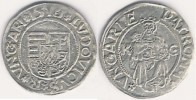
Huszár 841, Pohl 255-1, Unger 673m, Réthy II 306A, dated 1516 Hungary. Louis II (Lajos II in Hun.) (1516-1526). AR denar, 16 mm.
Obv: LVDOVICVS * R * VNGARI * 1516 *, Four-part shield with Hungarian arms (Ãrpádian stripes, patriarchal cross, Dalmatian leopard heads, Bohemian lion), Polish eagle in escutcheon.
Rev: PATRONA * â * VNGARIE, Crowned Madonna with infant Jesus to her right, KâG (privy mark) in fields.
The type was struck 1516-1527 (per Huszár, Pohl & Unger). This privy mark was struck in Kremnitz (formerly Körmöcbánya, Hungary, now Kremnica, Slovakia) by Georg Thurzó, who leased this mint from 1509-1516, when he withdrew and relocated to Augsburg (per Pohl), yet coins apparently continued to be struck with his mark through 1520.
Huszár/Pohl rarity rating 3.
Stkp
|
|

Beth El Talmud Torah of Flatbush (Brooklyn, New York)AE token, 32 mm., 10.96 g. (holed, probably as minted)
Obv: BETH EL TALMUD TORAH OF FLATBUSH around rim, GOD / WILL HELP beneath American flag, GREEN DUCK CO., CHI. in small letters around rim.
Rev.: 2131 EAST THIRTEENTH --BROOKLYN, N.Y. around rim, LOSE NOT / THIS LUCKY PIECE / AND THY FORTUNE / WILL INCREASE beneath Jewish star within horseshoe.
Ref.: None known.
No information available.
The Green Duck Company was founded by Greeburg and Duckheisel in Chicago in 1906 and remained there until it relocated to Mississippi in 1962, closing in 2004.Stkp
|
|

Elymais. Arsacid dynasty. Phraates (early-mid 2nd century A.D.)van't Haaff 14.4.1-1A; De Morgan 40; BMC plate XLI, 26-27; Sear GICV 5901; Alram --
AE drachm, 2.44 g., 14.46 mm. max., 90°
Obv: Bust facing forward, wearing tiara with two pellets in crescents and dotted rim, two diadem bands below tiara; to right, pellet in crescent above anchor with one or two crossbars at top; pellet border.
Rev: Plain diadem of two bands, pellet-in-crescents facing upward; pellet border.Stkp
|
|

Vietnam. Unofficial Coin. Attribution Unknown. Thiên Thánh Nguyễn BảoBarker 121.1-2 var. (seal script 天 Thiên); Toda 28 var. (The Rebel Phạm SÆ° Ãn); Zeno # 256791
AE 1 van; 1.51 g., 21.23 mm.
Obv: 天èå
寶 Thiên Thánh Nguyá»
n Bảo (seal script å
寶 Nguyá»
n Bảo)
Rev: plain and without a rim
A rebel named Phạm SÆ° Ãn rose in arms in the year 1391 and proclaimed himself king under the reign title Thiên Thánh. He was eventually captured and put to death. Several coins made at different times and in different styles bear his name. This coin is sometimes stated to have been cast ca. 1550-1600 but the source of that attribution is obscure.Stkp
|
|
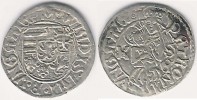
Huszár 803, Pohl 238-4, Unger 638e, Réthy II 276. Kaplan (pub. pending) Subtype A2Hungary. Wladislaus II (Ulászló II in Hun.) (1490-1516). AR denar, 16 mm.
Obv: M ⢠WLADISLAI.R ⢠VNGARIE â¢, Four-part shield with Hungarian arms (Ãrpádian stripes, patriarchal cross, Dalmatian leopard heads, Bohemian lion), Bohemian lion in escutcheon.
Rev: PATRONâVNGARIE â¢, Nimbate crowned Madonna with nimbate infant Jesus to her right, KâS/E (privy mark) in fields.
The type was struck 1490-1498 (per Unger) or 1492-1499 (per Pohl). This privy mark was struck in Kremnitz (formerly Körmöcbánya, Hungary, now Kremnica, Slovakia) by Stephanus Ryzmegl and Erasmus Rezl, joint unterkammergraffen (per Pohl) in 1497 (per Pohl & Unger).
Huszar/Pohl rarity rating 3. Kaplan subtype A is the standard form of this emission, in which the Madonna and infant Jesus are nimbate (described in Huszár, depicted in Unger & Réthy), and sub-subtype 2 is variety, in which there are neither annulets nor pellets to the sides of the shield (depicted in Réthy).
Stkp
|
|

Anonymous 12th Century Class II. Huszár 136; Toth-Kiss 19.17.3.1 sigla --/--; Unger 55; Réthy I 269; Frynas H.12.2; Lengyel 12/25; Adamovszky A150.Anonymous 12th Century Class II; attributed to Géza II (1141-1162) by Lengyel and tentatively attributed to him by Unger, Frynas and Adamovsky, but this attribution is not accepted by Huszár and Toth-Kiss.
AR bracteate denar (average: .12 g., 9.5-10.0 mm.), .11 g., 9.31 mm. max.
Obv: Bust facing holding cross in right hand and branch with three twigs in left hand.
Rev: Incuse of obverse.
Struck in Esztergom.
Huszár rarity R1, Toth-Kiss rarity 60, Unger rarity 15, Frynas rarity S. Unrecorded sigla, as confirmed by József Géza Kiss via personal email communication on January 5, 2019.Stkp
|
|

Schjöth 1547, Hartill (QC) 25.172 Type 1.1, Hartill (CCC) 22.1020, KM C 27-3Xianfeng (1851-1861)
1 cash (cast brass), 1851 [?] -1855 [?], Yunnan Province, Donghuan mint, 24 mm.
Obv: Xianfeng tongbao.
Rev: Boo dung.
Type 1 is comprised of coins with a square head tong, and are loosely based on the Board of Revenue Pattern.
Hartill (QC) rarity 8Stkp
|
|

Schjöth 1513, Hartill (QC) 6.113 Type B, Hartill (CCC) 22.598, KM C 2-3Daoguang (1821-1850)
1 cash (cast brass), 1824 [?] -1850 [?], Board of Works mint (in Beijing), auxiliary branch, 24 mm.
Obv: Daoguang tongbao.
Rev: Boo yuwan.
Type B is comprised of coins which have a small Guang, with the bottom left-hand stroke at an angle of about 60° to the horizontal. The coins issued by the auxiliary branch of the mint have a square head one dot tong.
There are many degenerate specimens of Type B, and it becomes hard to tell which were made by the official mint and which are the work of private forgers.
Hartill (QC) rarity 11Stkp
|
|

Schjöth 1501, Hartill (QC) 27.8-9 Type 2.1, KM 465Jiaqing (1796-1820)
1 cash (cast brass), 1803 [?]-1815, Zhili Province, Baoding mint, 21.5 mm.
Obv: Jiaqing tongbao.
Rev: Boo jyi.
Type 2 coins have a six stroke, open bei. They are smaller coins. Type 2.1 coins are comprised of those with a rectangular component in ji.
Hartill rarity 10Stkp
|
|

Bulgaria, Second Empire. Ivan Aleksandar (1331-1371) and Mihail Ansen IV (1331-1355)Dimnik & DobriniÃâ¡ 11/9.1.2; Raduchev & Zhekov Type I, 1.13.3-6; Youroukova & Penchev 74-80; LjubiÃâ¡ I, 6 (as Peter Asen)
AR Groši/grosh, Type II. struck circa 1331-1355; 1.32 g., 20.11 mm. max., 0°
Obv.: Christ standing facing before throne, raising hands in benediction, IC - XC (= Jesus Christ) and monograms (standing for Aleksandar and Tsar) across field.
Rev.: Ivan Aleksandar and his son Mihail Asen IV standing facing, each holding cross-tipped scepter, holding between them a long staff with a tripod-like base and a banner; monograms across inner fields above (standing for Aleksandar and Tsar) and outer fields below (for Pious and Mihail); stars flanking base of staff.Stkp
|
|

Isle of ManMackay 51; Pridmore 15; SCBC 7411; KM 7
AE/copper penny; Issued by James Murray, second Duke of Atholl (1736-1764), and struck at an unidentified mint in England. 11.13 g., 29.37 mm.max.
Obv: Entwined monogram AD (Atholl Dux) surmounted by a ducal coronet, 1758 below
Rev: QUOCUNQUE ⢠IECERIS ⢠STABIT, triskeles in center
Upon the death of James, tenth Earl of Derby in 1736, sovereignty of the Isle of Man passed into the hands of James Murray, second Duke of Atholl, who was the maternal grandson of James Stanley, seventh Earl of Derby (executed in 1651 as a Royalist during the English Civil War). This coinage, comprised of £250 in pennies (60,000 coins) and £150 pounds in half pennies (36.000 coins), was issued to address a currency shortage on the island. Due to the softness of the copper used, the coins tended to wear rapidly. His daughter, Charlotte Murray, Duchess of Atholl, and her husband, John Murray, third Duke of Atholl, sold their manorial rights in the Isle of Man to the Crown in 1765, but the coinage remained legal tender until 1786.Stkp
|
|

Huszár 566, Pohl 112-1, Unger 442a, Réthy II 114, Frynas 26.5, Toma plate I/8Hungary. Mária/Maria (1382-1387 solo reign; 1387-1395 with husband Zsigmond/Sigismund of Luxembourg)
AR denar; .65 g., 13.98 mm. max., 90°
Obv: + mOnETA mARIE [Gothic-style letters A], Patriarchal cross. pellet below.
Rev: + REGInE VnGARIE [Gothic-style letter A], Crowned M
The type was struck in only in 1383 (per Huszár, Unger and Frynas) or from 1383 through 1385 (per Pohl). It is traditionally viewed as the second of three denarii struck by Mária (after Huszár 565 and before Huszár 569). More recently, it has been viewed as Mária 's third type (per Gyöngyössi and Toma), struck in 1386-1387, ending when Zsigmond's coinage began (per Gyöngyössi). This coin, struck without a privy mark in the reverse fields, was probably struck in Buda (per Pohl).
Toma notes twelve legend variations among 456 coins of this type in the Cluj-MÃÆnÃÆÃ
Ÿtur Hoard, found in Cluj-Napoca, Romania (formerly, Kolozsvár, Hungary), in 1934 (but lists only eleven). They differ mainly in terms of completeness of legends, presence of pellets, and the styles of the letter A. Toma lists three variations among 302 coins struck in Buda (Pohl 112-1). The legends on this coin are as per Toma 1. Toma notes 260 coins with this combination.
Toma further notes three versions of the patriarchal cross and eight versions of the crowned M. There are fourteen obverse/reverse design combinations appearing among 411 coins from the hoard, all of which are listed by Toma as being among 271 Buda issues (Pohl 112-1). The cross on this coin is Toma C (wide cross with split ends and pellet below), which is linked to Toma's crowned Ms c-h; the crowned M appears to be Toma e. Toma notes 14 coins with the C/e combination.
Huszár/Pohl rarity rating 5; Frynas rarity C. The legend combination appearing on this coin is depicted/described in Unger, Réthy and Frynas. The legend combination depicted/described in Huszár and Pohl differs in that there are pellets between words on the obverse and reverse.Stkp
|
|

Mamluk (Bahri). Hasan (al-Nasir Nasir al-Din Abu'l-Mahasin) (1st reign, 748-752 A.H. = 1347-1351 A.D.; 2nd reign 755-762 A.H. = 1354-1361 A.D.)Balog 250 (Muhammad I); SNAT Hamah 526-527; Album 947
AE fals; Hamah mint, undated (2nd reign); 2.04 g., 17.84 mm. max., 0°
Obv.: Linear circle border in border of dots. Field on both sides divided by two horizontal lines into three segments (fesse): öñè (= duriba/struck) in upper segment; çÃâÃâ¦ÃâÃÆ Ã§ÃâÃâ çõñ (= al-Malik al-Nasir/King Nasir) in central segment; èÃÂÃâ¦Ã§Ã© (= Hamah) in lower segment.
Rev.: Shield divided by horizontal band into three horizontal segments (fesse). The central band is bendy of thirteen pieces to the left. Upper and lower segment contains a floral arabesque.
Hasan was the seventh son of Muhammad I to hold office. Upon the death of his half-brother, Sultan Hajji, in 1347, Hasan was raised to the sultanate at age 12 by senior Mamluk emirs formerly belonging to his father. Upon his accession, he disavowed his given (Turkic) name and assumed the Arabic name, Hasan. He was toppled by the emirs in 1351 when he attempted to assert executive authority, and reinstated by them three years later during a coup against his half-brother, Sultan Salih. During his second reign, he pursued a policy of minimizing the role of the mamluk emirs in the state and relying instead on the descendants of mamluks, known as awlad al-nas. Hasan was killed in 1361 at age 27 by one of his own mamluks, who led a faction opposed to Hasan's policy of elevating the awlad al-nas to positions of authority. Hasan was the only descendant of Muhammad to have had a significant impact on events in the sultanate, and was referred to by a Mamluk-era historian as one of the "best kings of the Turks."
Atribution courtesy of Alex KoifmanStkp
|
|

Hartill 20.57, Schjöth 1137, Fisherâs Ding 1895, Zeno #309235Ming Dynasty (1368-1644): Emperor Tai Zu (1368-1398)
1 cash/wen (cast bronze), cast in Nanjing; 3.41 g., 23.18 mm. max.
Obv: Hong Wu tong bao æ´ªæ¦é寶
Rev: Blank
Hartill rarity 14Stkp
|
|

Anonymous 12th Century Class I. Huszár 97 var.; Toth-Kiss 18.11.1.1 sigla h1.7/68; Unger 49 var.; Réthy I 83-84; Frynas H.11.7; Lengyel 11/13 var.; Adamovszky A102Anonymous 12th Century Class I; attributed to Béla II (1131-1141) by Lengyel and tentatively attributed to him by Unger, Frynas and Adamovszky , but this attribution is not accepted by Huszár, Toth-Kiss and Gyöngyössy.
AR denar (average: .20 g., 9.0-10.5 mm.), .24 g., 10.38 mm. max.
Obv: Horizontally oriented crosses within crescents above and below line.
Rev: Lines instead of an inscription, cross with four pellets.
Struck in Esztergom.
Huszár rarity 8, Toth-Kiss rarity 40, Unger rarity 32, Frynas rarity N.Stkp
|
|
| 1663 files on 19 page(s) |
1 |
 |
 |
 |
 |
|

|
